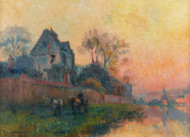Albert Lebourg (1 February 1849, Montfort-sur-Risle – 6 January 1928, Rouen)
Published by Therese Myles on 7th Apr 2020
Albert Lebourg was a French Impressionist painter. He was born in Montfort-sur-Risle on February 1, 1848. When studying architecture in Rouen, his interest in the art of painting grew when he made the acquaintance of landscape painter Victor Delamarre. Lebourg decided he would prefer to study at the Rouen School of Fine Art, where he was taught by Gustave Morin.
Before taking up a post as Professor of Drawing at a School of Fine Arts in Algeria, in 1872 Lebourg exhibited some of his landscape paintings in Rouen. While living in Algeria his style of painting was influenced by a painter he met called Jean Seignemartin. As a result, Lebourg’s Arabian subjects were lighter and brighter than his previous landscapes.
Lebourg returned to France briefly from Algiers for his wedding, which took place on September 8, 1873. He and his wife lived in Algeria until he resigned his teaching post in 1877 and went to Paris. There he worked in the studio of Jean Paul Laurens and encountered Impressionist artists.
When he began work on his own Impressionist style, Lebourg gained the artistic support of Camille Pissarro. In 1879 and 1880 his work appeared alongside paintings by Pissarro, Degas and Monet at the fourth and fifth annual Impressionist Exhibitions.
Lebourg found inspiration in the landscapes and seascapes of France. In the 1880s he painted landscapes and riverscapes, based on the countryside he visited in the Ile-de-France. He was particularly fond of the River Seine and the misty atmosphere of its banks. In 1883 and 1886 his paintings were exhibited at the Society of French Artists.
As well as regularly spending time in the Augergne, Lebourg went to Belgium, Switzerland, Holland and London. In Normandy the coastal towns of Boulogne, Honfleur and Dieppe provided suitable subjects for his harbour views and cityscapes.
In 1894 the French National Society of Fine Arts selected Lebourg for membership. Unfortunately the death of his wife that year had such a profound affect on him that for months Lebourg felt unable to paint.
Between 1890 and 1914 Lebourg worked on his highly acclaimed landcape paintings. Most of these were exhibited at the Salon of French Artists in Paris. For more than twenty years he entered paintings for the annual salon exhibitions and he received many prizes. He also did some fine figure drawings.
Lebourg was awarded a Silver Medal at the 1900 Internationale Universelle in Paris. A 1903 retrospective held at the Rosenberg Gallery showed more than one hundred of his paintings. In the same year Lebourg was rewarded with one of the highest accolades for his art, when he was given membership of the French Legion of Honor. His fame as an artist was firmly established and a second retrospective was arranged in 1918.
Lebourg moved back to Rouen in 1920, but became paralyzed after suffering a severe stroke. This prevented him from doing any more painting. He married his second wife in February 1921. Five years before his death on January 6, 1928, a Catalogue Raisonné of Albert Lebourg listed more than two thousand of his works.

